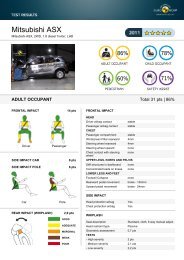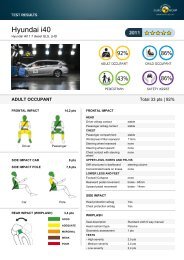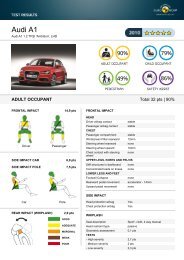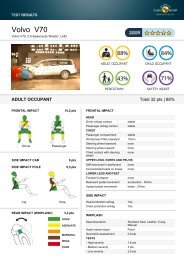Whiplash Testing Protocol - Euro NCAP
Whiplash Testing Protocol - Euro NCAP
Whiplash Testing Protocol - Euro NCAP
Create successful ePaper yourself
Turn your PDF publications into a flip-book with our unique Google optimized e-Paper software.
Version 3.1<br />
June 2011<br />
only be undertaken using dedicated lifting tools and associated locations on the dummy<br />
following the BioRID manufacturer recommendations. Typically, during the installation of<br />
BioRID the H-point will initially be installed further rearward in the seat than is required.<br />
Therefore the pelvis should be moved forward to achieve the target set-up positioning.<br />
6.6.2 Carefully place the seat belt across the dummy and lock as normal, ensure there is sufficient<br />
slack in the belt to allow positioning of BioRID.<br />
6.6.3 Align BioRID‟s midsagittal plane with the centreline of the seat.<br />
6.6.4 Adjust BioRID‟s midsagittal plane to be vertical; the instrumentation platform in the head<br />
should be laterally level.<br />
6.6.5 Adjust the pelvis angle to 26.5º from horizontal (± 2.5º).<br />
6.6.6 Position the H-Point 20mm forward (± 10mm) and at the same Z-height (± 10mm) as the<br />
location recorded in Section 6.5.3, while keeping the pelvis angle at 26.5º (± 2.5º). It is<br />
recommended to aim to set the ATD as close as possible to the nominal target values, and that<br />
the tolerance window should only be used if there is an issue achieving the required H-Point<br />
target or backset value. The BioRID setup tolerances are summarised in Table 1.<br />
6.6.7 Adjust the spacing of the legs so that the centreline of the knees and ankles is 200mm<br />
(±10mm) apart and ensure that the knees are level using an inclinometer or bubble gauge.<br />
6.6.8 Adjust the dummy‟s feet so that the heel of BioRID‟s shoe is resting on the heel surface. The<br />
tip of the shoe shall rest on the toe pan between 230mm and 270mm from the intersection of<br />
the heel surface and toe board, as measured along the surface of the toe board. Figure 2 shows<br />
proper positioning of the feet. Note, the heel point from a vehicle is not replicated, only heel<br />
plane height is set according to vehicle geometry.<br />
6.6.9 Position the BioRID‟s arms so that the upper arms are as close to the torso sides as possible.<br />
The rear of the upper arms should contact the seatback, and the elbows should be bent so that<br />
the small fingers of both hands are in contact with the top of the vehicle seat cushion with the<br />
palms facing the dummy‟s thighs.<br />
6.6.10 Level the instrumentation plane of the head (front/rear and left/right directions) to within ± 1º.<br />
Electronic tilt sensors shall be used to perform this check.<br />
6.6.11 The BioRID backset (as defined in Section 2.3.4) is the horizontal distance between the<br />
rearmost point on the head, and the same identifiable location on the head restraint that was<br />
found when measuring the HRMD in Section 6.4.1.<br />
6.6.11.1 Mark the farthest rearward point on the centreline of the dummy‟s skullcap. Note, as<br />
defined in 6.4, this point is 95mm from the top of the skullcap along the midsagittal plane<br />
of the skull measured using a tape that contours to the shape of the skullcap.<br />
6.6.11.2 Measure the BioRID backset, using the point identified on the skullcap in 6.6.11.1 and<br />
the same identifiable location on the head restraint that was found when measuring the<br />
HRMD in Section 6.4.1. See Figure 11.<br />
24
















